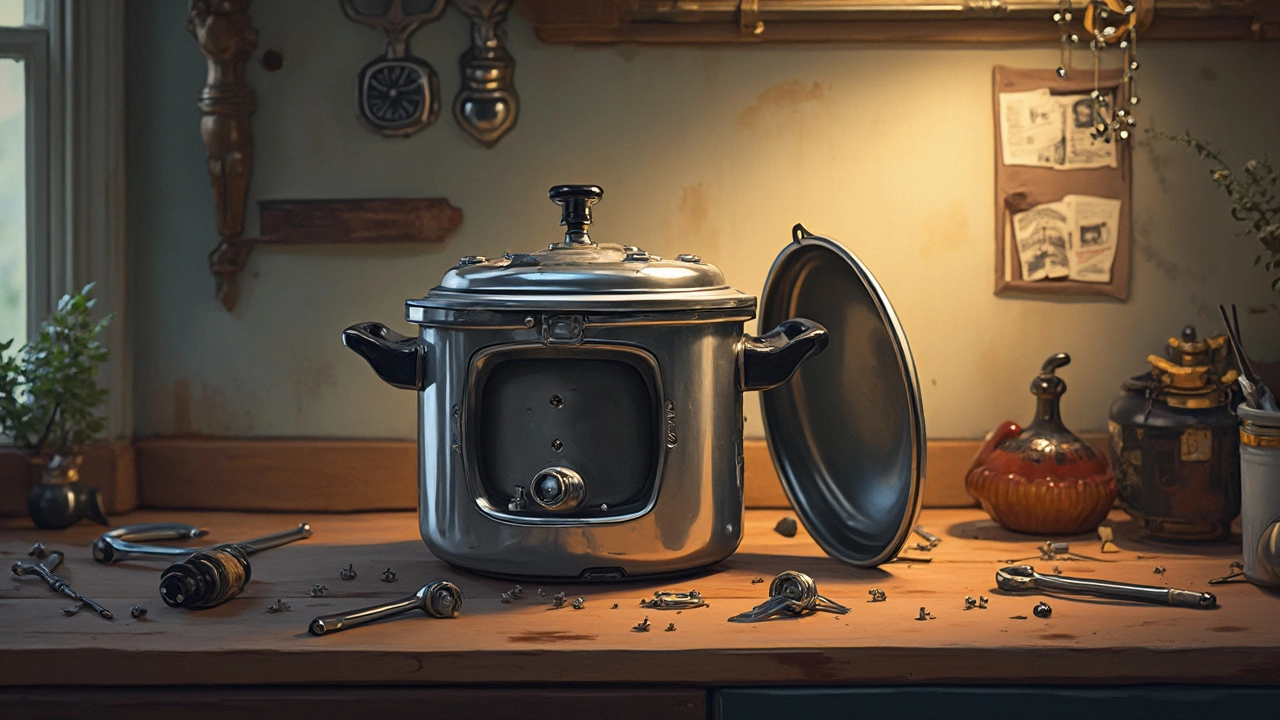So, your trusty pressure cooker is throwing a tantrum? Before you panic and head out to get a new one, let's talk about fixing it. Pressure cookers, just like anything else, can hit a snag here and there, but most of the time, they're totally fixable at home. Imagine the satisfaction of getting it back in shape without spending a ton of money on a new one!
One of the usual culprits is the gasket—the rubber ring that ensures things stay tight and secure. Over time, it can wear out or even split. Changing it is a pretty basic task, and new gaskets are easily available. Another troublemaker could be the pressure release valve. If your cooker isn't building pressure like it used to, a faulty valve might be to blame. Fortunately, these are generally fixable or replaceable without too much hassle.
But before you get your hands dirty, make sure you're geared up with the right tools and follow some safety measures—nobody wants a kitchen disaster when attempting a simple repair. By sticking to some straightforward troubleshooting steps, you can often pinpoint the issue and get everything working smoothly again. Cool, right?
- Understanding Common Pressure Cooker Problems
- Essential Tools for Basic Repairs
- Replacing the Pressure Cooker Gasket
- Fixing Pressure Release Valve Issues
- Addressing Pressure Loss Concerns
- Safety Tips for Repairing Pressure Cookers
Understanding Common Pressure Cooker Problems
Pressure cookers are like the superheroes of the kitchen world—they get things done fast and efficiently. But even superheroes have their off days. Most issues are common and knowing them can save you a ton of frustration.
One of the top problems? The gasket. This rubbery ring ensures that everything inside stays inside. Over time, the gasket might stretch, crack, or even get sticky. A pressure cooker repair in this area is usually as simple as replacing it. Always check if your gasket is seated properly, as this could also cause issues if it's not.
The pressure release valve is another usual suspect. If your pressure cooker isn't building up steam like it should, chances are this valve might be clogged or faulty. Cleaning it out or replacing it is a solid first step in solving the problem. Don’t forget about lid locks and seals—they play a vital role in maintaining pressure. If they’re not locking correctly, the cooker can't do its job.
Then there’s pressure loss. If your cooker isn’t reaching or maintaining pressure, check the tightness of the lid, the position of the pressure regulator, or the sealing ring. Sometimes, these parts just need a quick adjustment, and you're back in business.
And a quick note: some older models have quirks that modern designs have ironed out. So, if you’re working with a hand-me-down cooker, a little extra TLC might be necessary. A few careful checks can determine if you’re looking at a simple fix or something more complex.
Understanding these kitchen appliance fix fundamentals can take you a long way towards keeping your pressure cooker in top shape. Who doesn’t love that?
Essential Tools for Basic Repairs
Alright, so you're ready to roll up your sleeves and start fixing that pressure cooker. But hold on a sec, what tools do you actually need? Don't worry, you won't have to raid a hardware store for this—a few basic items will do just fine.
First up, get your hands on a set of screwdrivers. A flathead and a Phillips head are your go-to companions here since most pressure cooker components are held in by these types of screws. Having a small-sized set might come in handy for those tiny screws you don't want to strip.
Next, you'll want some pliers. Pliers are super handy for gripping tight components or pulling things apart gently. A pair of needle-nose pliers can be especially useful if you need to work in tight spots or grab little parts.
If you're dealing with a really finicky part or something that's stuck, a wrench could be your best buddy. An adjustable wrench is ideal because it can fit different sizes, saving you from needing a whole set.
- Gasket Removal Tool: This isn't strictly necessary, but it makes getting a stubborn old gasket out a lot easier without tearing it apart.
- Replacement Parts: Having spare gaskets, valves, or other small components specific to your pressure cooker model can make your life a whole lot easier when something needs swapping out.
- Cleaning Supplies: A brush or some rubbing alcohol can help clean grime off parts before you put everything back together for a smoother fit.
In some cases, manuals or guides specific to your pressure cooker brand can be real lifesavers. They're not tools in the classic sense, but knowing what's what before you start poking around can keep you from making something worse. And remember, don't skip the safety gear—a pair of protective gloves and some safety glasses can keep those little DIY surprises from turning into larger issues.
Replacing the Pressure Cooker Gasket
Alright, let's get your pressure cooker back in action. The gasket is like the unsung hero of your pressure cooker, making sure it seals properly to build pressure and cook your food evenly. Over time, though, it can wear out or get damaged, which is not what you want when you're all set to whip up some tasty meals.
First things first, how do you know if the gasket's the problem? A quick check would be looking for any visible cracks or brittleness. If your cooker isn't sealing properly, that's a big sign too.
So, let's dive into how you can replace it:
- Buy the right gasket: Make sure you grab the correct size that fits your pressure cooker model. A mismatched gasket will do you no good.
- Remove the old gasket: Carefully pull the old one out. Sometimes it can be a bit stuck, so gently does it!
- Clean the groove: Believe it or not, gunk can build up in the groove where the gasket sits. Give it a good clean with a damp cloth to ensure it’s ready for the new gasket.
- Fit the new gasket: Place it in the groove evenly all around the lid. Make sure it's not twisted because that would cause trouble later on.
- Test it out: Seal up your cooker and do a test run with water to see if it's holding pressure effectively.
A little pro tip: keep that gasket away from oil and grease as they can deteriorate the material faster.
Now, some folks ask how often they should change it. Generally, consider replacing it every 12-18 months, but give it a good check regularly, especially if you notice any hiccups in performance.
Earlier studies showed that a well-maintained pressure cooker saves about 70% of cooking time compared to traditional methods. So, putting a tad bit of effort into the upkeep, like changing the gasket, pays off big time in the kitchen!

Fixing Pressure Release Valve Issues
Alright, let's zero in on that pressure release valve. It’s key for safe cooking and ensuring things don’t get too steamy inside your pressure cooker. If it's acting up, you're in the right place to get it sorted. Trust me, it's less daunting than it sounds!
First off, check the valve for any obvious blockages. These could be tiny food particles that somehow snuck through. Simply give it a good rinse under warm water, making sure it's nice and clean. If that did the trick, great! If not, let's dig a bit deeper.
Next, ensure the valve isn’t misplaced or loose. A valve that's not sitting right can be a real headache and the reason your cooker isn't building pressure. If you notice it’s loose, tightening it might be all you need to do. Give it a firm twist while keeping safety in mind, of course.
If cleaning and tightening don’t work, it might be time to replace the valve. Luckily, getting a new pressure release valve is straightforward. You’ll want to get the exact model to ensure compatibility. Here's a quick step-by-step on replacing it:
- Unplug your cooker and let it cool completely to avoid any burns.
- Find your valve's model number, usually located on the stem or the packaging it came in.
- Purchase the correct replacement valve either online or from a local appliance store.
- Follow the manufacturer’s instructions for removal and installation; it’s typically a simple unscrew-and-replace process.
If you're feeling fancy, slacken the valve and sprinkle around some soapy water. If bubbles form when you pressurize the cooker, the valve might still be leaking, indicating something's amiss with the seal.
And hey, if repairs aren’t your thing, reaching out to someone who handles pressure cooker repair could save you a world of frustration.
Addressing Pressure Loss Concerns
If your pressure cooker isn't holding up the pressure like it used to, don't rush to dump it in the trash. Pressure loss is a common issue and can be sorted out with some basic checks and fixes. It's a bit like dealing with a flat tire—not fun, but manageable.
First off, let's talk gaskets. These rubber rings are at the heart of keeping everything airtight. If you’re noticing a pressure drop, give the gasket a once-over. Is it looking battered or out of place? If you spot any wear or damage, it's time to replace the pressure cooker gasket with a fresh one. They’re usually inexpensive and can make a world of difference.
Your next suspect is the pressure release valve. This little fellow can sometimes get clogged with food debris or just become faulty over time. Check if it’s stuck or not sealing properly. Cleaning it or replacing the valve can usually solve the issue.
Let’s not forget about the lid. If it's not closed properly, it won’t seal right and, surprise, there goes your pressure. Double-check that the lid fits snugly and locks into place as it should.
Wondering if there's something more techie going on with electric pressure cookers? They come with additional parts like sensors and switches. If all else fails and you’ve tried the obvious fixes, it might be worth checking if the sensors are clean and functioning. These ins and outs can be a tad more complex, but identifying and addressing them can often save your appliance.
Here's a quick list to tackle pressure loss:
- Examine the gasket for damage or deformity; replace if necessary.
- Inspect and clean the pressure release valve to ensure it’s not clogged.
- Ensure the lid closes and locks securely.
- For electric models, check that sensors and switches are clean and operational.
Safety Tips for Repairing Pressure Cookers
Alright, so you’re all set to fix up that pressure cooker. But wait, safety first! It's super important because a botched repair job can lead to more problems than you started with—not to mention potential hazards. Let's make sure this repair journey is not only smooth but safe too.
First off, always work with the appliance unplugged. No exceptions here. Electricity and water aren’t pals, so playing it safe is key. If your cooker runs on a separate electric base, tuck that away until the downtime is over.
- Check the Pressure: Ensure there’s absolutely no pressure left inside before you even think about taking the lid off. Lift the valve slowly, keep face and hands away, and remember patience is your friend here.
- Avoid Wet Surfaces: Don’t work on the cooker near water or with wet hands. Slipping or short-circuiting isn’t fun.
- Use the Right Tools: Using inappropriate tools can damage parts and spoil your repair game. Keep a handy kit with basic screwdrivers, pliers, and replacement parts like gaskets and valves.
- Follow the Manual: If you’ve still got that manual or can download it, follow the instructions closely. It’s like a roadmap designed just for your cooker model.
- Tags Matter: Always replace seals and gaskets with the actual model-specific parts. Generic ones might save a buck, but they won’t guarantee a proper fit or function.
Planning to add in new parts? Do a quality check. Authenticity isn’t just a fancy word—it’s the best way to ensure longevity during your repair efforts.
And here's a bit of data to chew on: according to a local repair shop survey, 75% of pressure cooker issues can be effectively managed at home just by swapping out worn parts like the gasket and valve. But even simple fixes need cautious handling for a long-lasting cooker.
Nail down these safety steps, and you’ll be back on the home cooking trail in no time, without any drama! Why risk it when you could fix it smart and safe, right?


